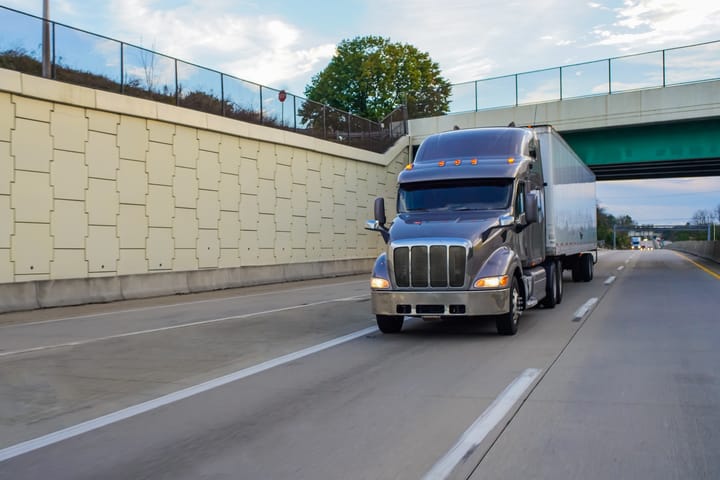Simplified LTL classification
Plus: Trucking groups applaud EPA

If LTL classifications read like tax law or a foreign language, you're not alone. The system can be confusing, but a big change to how freight is categorized is coming up this summer. We chat with the National Motor Freight Traffic Association for tips to navigate it all.
Beyond that, we’re covering the EPA’s review of emissions rules, how small fleets are standing out to win shippers' business, and why strong industry relationships still matter. Plus, we break down the latest on broker transparency, nuclear verdicts, and the growing role of connectivity in trucking.

⬇️ $3.549
AVG. COST OF DIESEL PER GALLON IN U.S. AS OF 3/17, DOWN 0.033¢
Source: U.S. Energy Information Administration

A newer, simpler way to classify LTL freight
Starting in July, less-than-truckload freight will have a different classification structure. The current rating system is 90 years old, and the changes aim to make the system more user-friendly, with a greater emphasis on freight density.
We caught up with Keith Peterson, director of operations for the National Motor Freight Traffic Association, which is the organization publishing the freight classifications. - Shefali Kapadia
What's the biggest point of confusion or overlooked factor in the new LTL classifications?
Many focus on items shifting to full density, but a key change often overlooked is the consolidation of generic headings. By streamlining the NMFC, the classification system becomes easier to navigate, reducing complexity and making freight classification more intuitive for shippers and carriers alike.
How do you think the change will help the trucking industry and what challenges or pain points does it address?
The NMFC changes that are set to take effect on July 19, 2025, simplify two key steps: finding the correct item number and assigning a class based on density. While there will be an adjustment period as the industry adapts to collecting dimensions and calculating density, the long-term impact will be a more straightforward and consistent classification process—reducing confusion, improving accuracy and streamlining operations for both shippers and carriers.
Any downsides to the changes?
From our perspective, no, not really! The shift will encourage greater focus on how freight is prepared and presented for shipment. In the long run, this added attention will lead to improved packaging methods, ensuring freight is better protected and ready for transport.
What's your No. 1 piece of advice to small fleet owners and execs aiming to navigate the changes?
Communicate with your shippers early about providing accurate dimensions before shipment. Emphasize the importance of proper packaging and explore ways to reduce “dead air” to increase density while still protecting the freight. A well-prepared shipment means fewer issues, better efficiency and smoother operations. We have a helpful website that we encourage all who ship LTL freight to visit: www.nmfcchanges.com.

Why relationships and connections still matter in trucking
As trucking and logistics have evolved, the industry is about more than moving goods from point A to B.
"It’s about being prepared for whatever challenges the road throws your way," says Mark Reeder, general manager of Hoyt’s Truck Center.
A key factor in being prepared: building a strong network of relationships with suppliers, industry professionals and repair shops. If something goes wrong on the road, truckers and managers can rely on their solid connections to keep operations running smoothly.
Why this matters: When disruptions (inevitably) happen, having a reliable support network can minimize downtime. This means that trucking owners can keep their businesses resilient and their wheels turning, even when circumstances are unpredictable.
Get more details from Miles and Mentors Trucking Podcast on LinkedIn.

IN PHOTOS: New tech and trucks showcased at ATA's TMC
END OF OPS: 51-year-old trucking company shutters, lays off drivers
MURDER CHARGE: Employee charged with fatally stabbing trucking CEO
CDL STANDARDS: American Truckers United supports bill for stricter CDLs

"With the rise of social media, I see a lot of carriers doing a really good job of getting their brand out, working their brand, differentiating themselves, because that's the key to win business." - Adam Wingfield, Innovative Logistics Group
Everyone recognizes the big-name trucks on the road, from Schneider to J.B. Hunt. But small carriers make up a significant portion of the trucking industry, and they're finding ways to differentiate themselves to win business from shippers. Wingfield, who advises and consults small biz trucking firms, talks all about the future of small carriers. Watch here.

OOIDA, ATA praise Trump's plan to reconsider emission rules
Two major trucking groups applauded the Environmental Protection Agency’s decision to review two rules related to emissions that would impact the industry: GHG3 and NOx. The first aimed to curb greenhouse gas emissions from trucks starting with model year 2027, and the second sought to curb emissions from new trucks by up to 90% by 2031.
Why this matters: Biden-era emissions regulations have been up in the air since Trump took office, leaving OEMs and trucking owners in a lurch about the future of EVs. The Owner-Operator Independent Drivers Association claimed small fleet owners would be "suffocated" by these rules, due to the higher costs of low- or zero-emission trucks. (Trucking Dive)
Trucking lawyers argue in favor of broker transparency
As the FMCSA's broker transparency proposal wraps up its second round of comments, two attorneys have expressed that they're in favor of the laws being enforced. Their reason? The laws are critical to crack down on embezzlement and fraud.
Why this matters: There's a strong divide over broker transparency regulations. Those in favor argue it would protect small fleets and improve rates with more visibility into broker charges. But those against say increased regulations would harm carriers, brokers, shippers and consumers. (Overdrive)
Record-breaking nuclear verdicts hit trucking industry
Average jury awards against trucking companies have skyrocketed, now exceeding $22 million. A major driver of this trend is the perception that fleets prioritize profits over safety, which heavily influences jurors’ decisions. Between 2012 and 2022, the average verdict surged by 967%. As Kevin Mulvaney, a partner at Wilson Elser, put it at the 2025 Best Fleets to Drive For conference in Charlotte, N.C., “There’s no such thing as too much insurance.”
Why this matters: The growing threat of multi-million-dollar verdicts is forcing fleet owners to rethink how they manage risk. They may need post-accident strategies, more robust insurance policies and various technologies that protect drivers and provide evidence in case of a trial. (Truck News)

Connectivity is trucking's next big fundamental change
Better data sharing is leading to increased connectivity in trucking, and that could truly transform the industry, according to Jack Kennedy, the CEO of telematics provider Platform Science. Data from trucks, trailers, freight, warehouses and much more would come together to form a comprehensive look at freight management.
Why this matters: With sensors and tracking devices, the trucking industry has abundant data. But if the data is kept in silos, it's not much use to overall freight management. That's where connectivity comes in, using data from various parts of the freight network to form business insights and help decision-making. (Transport Topics)

Thanks for reading today's edition! You can reach the newsletter team at editor@theinsidelane.co. We enjoy hearing from you.
Interested in advertising? Email us at newslettersales@mvfglobal.com
The Inside Lane is curated and written by Shefali Kapadia and edited by Bianca Prieto.





Comments ()